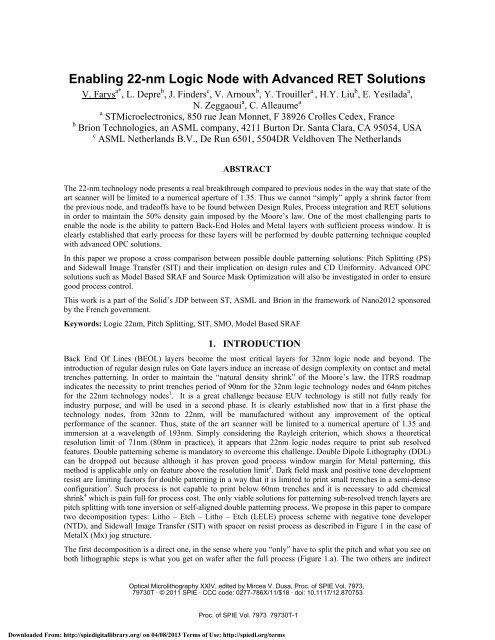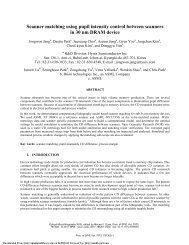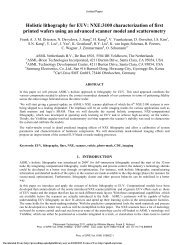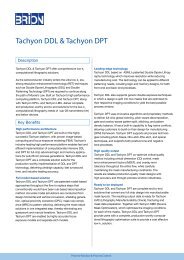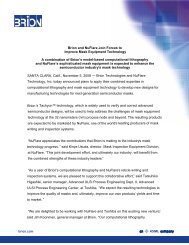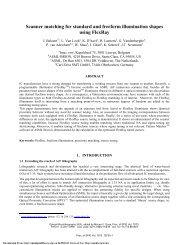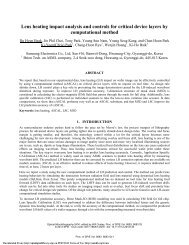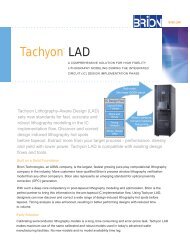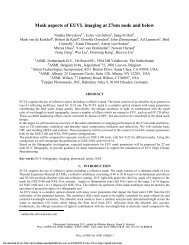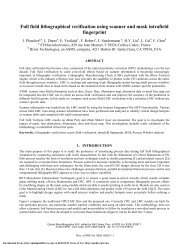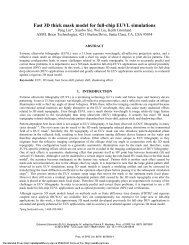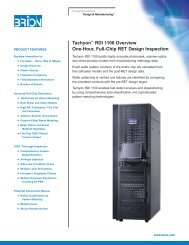Enabling 22-nm Logic Node with Advanced RET Solutions
Enabling 22-nm Logic Node with Advanced RET Solutions - Brion ...
Enabling 22-nm Logic Node with Advanced RET Solutions - Brion ...
- No tags were found...
You also want an ePaper? Increase the reach of your titles
YUMPU automatically turns print PDFs into web optimized ePapers that Google loves.
<strong>Enabling</strong> <strong>22</strong>-<strong>nm</strong> <strong>Logic</strong> <strong>Node</strong> <strong>with</strong> <strong>Advanced</strong> <strong>RET</strong> <strong>Solutions</strong><br />
V. Farys a* , L. Depre b , J. Finders c , V. Arnoux b , Y. Trouiller a , H.Y. Liu b , E. Yesilada a ,<br />
N. Zeggaoui a , C. Alleaume a<br />
a STMicroelectronics, 850 rue Jean Monnet, F 38926 Crolles Cedex, France<br />
b Brion Technologies, an ASML company, 4211 Burton Dr. Santa Clara, CA 95054, USA<br />
c ASML Netherlands B.V., De Run 6501, 5504DR Veldhoven The Netherlands<br />
ABSTRACT<br />
The <strong>22</strong>-<strong>nm</strong> technology node presents a real breakthrough compared to previous nodes in the way that state of the<br />
art scanner will be limited to a numerical aperture of 1.35. Thus we cannot “simply” apply a shrink factor from<br />
the previous node, and tradeoffs have to be found between Design Rules, Process integration and <strong>RET</strong> solutions<br />
in order to maintain the 50% density gain imposed by the Moore’s law. One of the most challenging parts to<br />
enable the node is the ability to pattern Back-End Holes and Metal layers <strong>with</strong> sufficient process window. It is<br />
clearly established that early process for these layers will be performed by double patterning technique coupled<br />
<strong>with</strong> advanced OPC solutions.<br />
In this paper we propose a cross comparison between possible double patterning solutions: Pitch Splitting (PS)<br />
and Sidewall Image Transfer (SIT) and their implication on design rules and CD Uniformity. <strong>Advanced</strong> OPC<br />
solutions such as Model Based SRAF and Source Mask Optimization will also be investigated in order to ensure<br />
good process control.<br />
This work is a part of the Solid’s JDP between ST, ASML and Brion in the framework of Nano2012 sponsored<br />
by the French gover<strong>nm</strong>ent.<br />
Keywords: <strong>Logic</strong> <strong>22</strong><strong>nm</strong>, Pitch Splitting, SIT, SMO, Model Based SRAF<br />
1. INTRODUCTION<br />
Back End Of Lines (BEOL) layers become the most critical layers for 32<strong>nm</strong> logic node and beyond. The<br />
introduction of regular design rules on Gate layers induce an increase of design complexity on contact and metal<br />
trenches patterning. In order to maintain the “natural density shrink” of the Moore’s law, the ITRS roadmap<br />
indicates the necessity to print trenches period of 90<strong>nm</strong> for the 32<strong>nm</strong> logic technology nodes and 64<strong>nm</strong> pitches<br />
for the <strong>22</strong><strong>nm</strong> technology nodes 1 . It is a great challenge because EUV technology is still not fully ready for<br />
industry purpose, and will be used in a second phase. It is clearly established now that in a first phase the<br />
technology nodes, from 32<strong>nm</strong> to <strong>22</strong><strong>nm</strong>, will be manufactured <strong>with</strong>out any improvement of the optical<br />
performance of the scanner. Thus, state of the art scanner will be limited to a numerical aperture of 1.35 and<br />
immersion at a wavelength of 193<strong>nm</strong>. Simply considering the Rayleigh criterion, which shows a theoretical<br />
resolution limit of 71<strong>nm</strong> (80<strong>nm</strong> in practice), it appears that <strong>22</strong><strong>nm</strong> logic nodes require to print sub resolved<br />
features. Double patterning scheme is mandatory to overcome this challenge. Double Dipole Lithography (DDL)<br />
can be dropped out because although it has proven good process window margin for Metal patterning, this<br />
method is applicable only on feature above the resolution limit 2 . Dark field mask and positive tone development<br />
resist are limiting factors for double patterning in a way that it is limited to print small trenches in a semi-dense<br />
configuration 3 . Such process is not capable to print below 60<strong>nm</strong> trenches and it is necessary to add chemical<br />
shrink 4 which is pain full for process cost. The only viable solutions for patterning sub-resolved trench layers are<br />
pitch splitting <strong>with</strong> tone inversion or self-aligned double patterning process. We propose in this paper to compare<br />
two decomposition types: Litho – Etch – Litho – Etch (LELE) process scheme <strong>with</strong> negative tone developer<br />
(NTD), and Sidewall Image Transfer (SIT) <strong>with</strong> spacer on resist process as described in Figure 1 in the case of<br />
MetalX (Mx) jog structure.<br />
The first decomposition is a direct one, in the sense where you “only” have to split the pitch and what you see on<br />
both lithographic steps is what you get on wafer after the full process (Figure 1.a). The two others are indirect<br />
Optical Microlithography XXIV, edited by Mircea V. Dusa, Proc. of SPIE Vol. 7973,<br />
79730T · © 2011 SPIE · CCC code: 0277-786X/11/$18 · doi: 10.1117/12.870753<br />
Proc. of SPIE Vol. 7973 79730T-1<br />
Downloaded From: http://spiedigitallibrary.org/ on 04/08/2013 Terms of Use: http://spiedl.org/terms
decompositions <strong>with</strong> the first lithographic step that permits to define structure supporting spacer deposition and<br />
second lithography extra features removal. One particularity of the SIT process is the possibility to pattern the 1 st<br />
lithographic step on both ways as described in Figure1.b and Figure1.c and resulting in the same output. It is due<br />
to the fact that lines at half pitch are derived from the 1 st lithographic lines at pitch after spacer deposition<br />
process. In that sense pitch’s lines and half pitch lines can be reversed.<br />
(a)<br />
64 <strong>nm</strong><br />
60 <strong>nm</strong><br />
32 <strong>nm</strong><br />
(b)<br />
(c)<br />
Litho1<br />
Litho2<br />
Figure 1 – Splitting comparison for Metal jog structure <strong>with</strong> 1 st litho on the left and 2 nd litho<br />
on the right; a) double patterning <strong>with</strong> LELE scheme, b) Sidewall Image Transfer 1 st<br />
decomposition (SIT1), c) Sidewall Image Transfer 2 nd decomposition (SIT2)<br />
We propose to compare these two decomposition style (1 LELE and 2 SIT) on 64<strong>nm</strong> pitch Mx jog structure <strong>with</strong><br />
32<strong>nm</strong> line and 60<strong>nm</strong> of gap.<br />
2. DOUBLE PATTERNING PROCESS FLOW<br />
The number of steps increase in a double patterning flow regarding standard single patterning process. We can<br />
count 2 steps <strong>with</strong> one lithographic and one etch step in a single patterning flow. On the Figure 2 we have<br />
reported the process flow in the case of pitch splitting method <strong>with</strong> Litho-Etch-Litho-Etch process flow.<br />
For this LELE we have five steps <strong>with</strong> two consecutive litho-etch steps and one alig<strong>nm</strong>ent step between the first<br />
and second exposure. On this figure we have reported the case of the Mx jog. The first lithographic step (Litho1)<br />
consists in printing trenches <strong>with</strong>in resist deposit on a hard mask. The first etch step (Etch1) permits to transfer<br />
the trench into the hard mask. Then this operation is repeated after alig<strong>nm</strong>ent of the second mask and resist’s<br />
film deposition, <strong>with</strong> trench patterning (Litho2) and transfer into hard mask (Etch2).<br />
Proc. of SPIE Vol. 7973 79730T-2<br />
Downloaded From: http://spiedigitallibrary.org/ on 04/08/2013 Terms of Use: http://spiedl.org/terms
Litho1<br />
Etch1<br />
Figure 2 – Process flow for a double<br />
patterning scheme based on Litho-<br />
Etch-Litho-Etch (LELE) process<br />
Litho2<br />
Etch2<br />
For the SIT we can list six consecutive steps. On the Figure 3 we have reported the four principal steps of the<br />
process flow for both decomposition (SIT1 and SIT2). The first lithographic step consists in patterning line of<br />
resist on top of a hard mask (Litho1). A spacer deposition is performed during the second step (Spacer) <strong>with</strong> a<br />
etch back and stripping process to remove supporting line of resist. Thus it remains spacer features at half pitch<br />
regarding line of resist of the 1 st lithographic step. The spacer profile depends on the 1 st lithographic step as<br />
highlighted between Figure 3.a and Figure 3.b. The second mask is then aligned and exposed in order to create<br />
plug of resist in the extra features area (Litho2). By this way we can define the metal line-end as well as<br />
removing dummies supporting line used for spacer growth. Then the final etch transfer the pattern <strong>with</strong>in the<br />
hard mask defining the Mx jog structure requested (Etch).<br />
Proc. of SPIE Vol. 7973 79730T-3<br />
Downloaded From: http://spiedigitallibrary.org/ on 04/08/2013 Terms of Use: http://spiedl.org/terms
Litho1<br />
Litho1<br />
Spacer (+ resist strip)<br />
Spacer (+ resist strip)<br />
Litho2<br />
Litho2<br />
Etch<br />
Etch<br />
(a)<br />
(b)<br />
Figure 3 – Process flow for a double patterning scheme based on SIT process flow (Litho-<br />
Spacer-Litho-Etch); a) 1 st SIT decomposition type (SIT1), b) 2 nd SIT decomposition type (SIT2).<br />
Between these 2 decomposition only the Litho1 step is different<br />
By looking at the final outputs between LELE, SIT1 and SIT2 we can see some obvious differences on the<br />
contour shapes. Actually LELE structures present rounded line-end whereas SIT has straight line-end definition<br />
due to the fact that it is cut by the second exposure. Moreover we can see some risk of pinching on horizontal<br />
line of the 2D shape for LELE and SIT1 whereas this risk is minimized on SIT2.<br />
These contour differences highlight the fact that CD variability will be dependent on the double patterning<br />
scheme that will be used. Thus we propose to compare the CD uniformity for each of these decompositions.<br />
3. CD UNIFORMITY CALCULATION<br />
We propose to use an edge-based method to determine the CD uniformity apply on 2D jog structures. The<br />
principle is to take into account independently the CDU contribution from each edge considering the 3σ<br />
variability from lithography budget and process step (etch, overlay, etc…). The CDU calculation for a gap<br />
between line-ends of two consecutive lithographic steps is describe on the Figure 4.<br />
Proc. of SPIE Vol. 7973 79730T-4<br />
Downloaded From: http://spiedigitallibrary.org/ on 04/08/2013 Terms of Use: http://spiedl.org/terms
Litho1<br />
Litho2<br />
e 2<br />
e 1<br />
Figure 4 – Edge-based CD uniformity<br />
calculation method. CD variability<br />
(3σ) from each edge are independently<br />
taken into account and then<br />
recombined to determine the final<br />
CDU (3σ) between edges e 1 and e 2<br />
e 2<br />
Etch 2 (3σ)<br />
CD Litho2 (3σ)<br />
Litho1<br />
e 1<br />
Etch 1 (3σ)<br />
CD Litho1 (3σ)<br />
Litho2<br />
On this figure, we consider that the CDU (3σ) of the gap between edges e 1 and e 2 (gap e 1 -e 2 ) is impacted by the<br />
variability of edge e 1 from the Litho1 step, including respectively half of CD Litho1 (3σ) and Etch 1 (3σ) from<br />
lithographic and etch dispersion, and the variability of edge e 2 from Litho2 step (driven by half of CD Litho1 (3σ)<br />
and Etch 1 (3σ)). On top of that we have also to consider the variability coming from the overlay between Litho1<br />
and Litho2. Considering all these variability we can derive a global CD uniformity (3σ) between edges of two<br />
different exposure steps as mention in Equation (1).<br />
Gap<br />
⎛ CD<br />
⎝ 2<br />
⎞<br />
2<br />
⎛ Etch ⎞<br />
⎝ 2 ⎠<br />
Litho1<br />
1<br />
2 Litho2<br />
2 ⎞<br />
( 3 ) = ⎜ ⎟ + ⎜ ⎟ + + ⎜ ⎟ + ⎜ ⎟<br />
1−e<br />
σ<br />
OVL<br />
2<br />
⎠<br />
e<br />
⎠<br />
2<br />
⎛ CD<br />
⎝ 2<br />
⎞<br />
⎠<br />
2<br />
⎛ Etch<br />
⎝ 2<br />
2<br />
(1)<br />
Then we can apply this global CDU calculation to the three different kinds of splitting strategy: LELE, SIT1 and<br />
SIT2. We propose to look deeper on the variability of the gaps between line-ends and 2D shape (Gap1 and<br />
Gap2) as well as horizontal line of the 2D shape (Line). On the Figure 5 we have reported these three<br />
decomposition style <strong>with</strong> the corresponding lithographic steps and the CD variability needed for the calculation.<br />
For the LELE process scheme (Figure 5.a) we can calculate the CDU for Gap1, Gap2 and Line as a function of<br />
the CD 1 and CD 2 of first lithographic step and CD 3 of second one. The equation (2) permits to determine the 3σ<br />
CD variability for the Gap1 where we can see that it is exclusively driven by the first patterning step. This<br />
variability is similar to a single patterning approach. The equation (3) represents the variability for the Gap2<br />
which is different from Gap1 in a sense where it is impacted by the double patterning steps. That’s for why<br />
lithographic variation from each steps (CD 2 and CD 3 ) as well as etch of first and second patterning (Etch 1 and<br />
Etch 2 ) and overlay error (OVL) are taking into account. The Line variability is simply driven by the first<br />
patterning step <strong>with</strong> lithography (CD 2 ) and etching (Etch 1 ) contributions as detailed in Equation (4).<br />
Proc. of SPIE Vol. 7973 79730T-5<br />
Downloaded From: http://spiedigitallibrary.org/ on 04/08/2013 Terms of Use: http://spiedl.org/terms
Litho1<br />
Litho2<br />
Litho1<br />
Litho1<br />
Litho1<br />
Litho1<br />
CD 1<br />
Gap1 Gap2<br />
Line<br />
CD 2<br />
CD 3<br />
CD 4<br />
Gap1 Gap2<br />
Line<br />
Litho2<br />
CD 5 CD 6<br />
Gap1 Gap2<br />
Line<br />
Litho2<br />
CD 5<br />
CD 3 CD 7<br />
(a)<br />
(b)<br />
(c)<br />
Figure 5 – CD variability definition of both patterning steps for every decomposition style, a) LELE scheme, b)<br />
SIT 1 st decomposition (SIT1) and c) SIT 2 nd decomposition (SIT2)<br />
2<br />
2<br />
( 3σ<br />
) = CD<br />
Gap 1 + Etch<br />
1<br />
1<br />
(2)<br />
Gap<br />
2<br />
2<br />
2<br />
2<br />
⎛ CD2<br />
⎞ ⎛ CD3<br />
⎞<br />
2 ⎛ Etch1<br />
⎞ ⎛ Etch2<br />
⎞<br />
2 = + + OVL + + ⎟<br />
⎠<br />
( 3σ<br />
)<br />
⎜<br />
⎝<br />
2<br />
⎟<br />
⎠<br />
⎜<br />
⎝<br />
2<br />
2<br />
( 3σ<br />
) = CD Etch<br />
Line +<br />
2<br />
1<br />
2<br />
⎟<br />
⎠<br />
⎜<br />
⎝<br />
2<br />
⎟<br />
⎠<br />
⎜<br />
⎝<br />
2<br />
(3)<br />
(4)<br />
On the Figure 5.b we have reported the first decomposition style for Sidewall Image transfer (SIT1). In that<br />
process the spacer deposition does not impact the overall variability of Gap1, Gap2 and Line. Indeed, the Gap1<br />
variability is exclusively driven by the second exposure step of the block mask <strong>with</strong> the CD 5 contribution from<br />
lithography and the final Etch (Etch) as described in the Equation (5). The Equation (6) describes the variability<br />
for Gap2 where lithography contributions from first step (CD4) and second step (CD6) are taken into account as<br />
well as overlay (OVL) and etching steps (Etch). As it is the case for LELE scheme, we can also notice a double<br />
CDU distribution between Gap1 and Gap2 due to the fact that the first distance is impacted by single exposure<br />
step whereas second one is impacted by double patterning process. Finally the Line variability is only driven by<br />
lithographic (CD 4 ) and etching (Etch) components.<br />
2<br />
2<br />
( 3σ<br />
) = CD<br />
Gap 1 + Etch<br />
5<br />
(5)<br />
2<br />
⎛ CD ⎞ ⎛ CD ⎞<br />
Gap 2 ⎜ ⎟ ⎜ ⎟ + Etch<br />
⎝ 2 ⎠ ⎝ 2 ⎠<br />
4<br />
2 6<br />
2<br />
( 3σ<br />
) = + OVL +<br />
2<br />
(6)<br />
Proc. of SPIE Vol. 7973 79730T-6<br />
Downloaded From: http://spiedigitallibrary.org/ on 04/08/2013 Terms of Use: http://spiedl.org/terms
2<br />
( 3σ<br />
) = CD<br />
2<br />
Etch<br />
Line +<br />
4<br />
(7)<br />
The last decomposition (Figure 5.c) represents the Sidewall Image Transfer of the second decomposition style<br />
(SIT2) where only the first lithographic step is different regarding SIT1. In that case, although there is a slight<br />
change on the first lithographic step we can see that spacer deposition as to be taken into account in the<br />
definition of the 2D shape structure as well as the gap <strong>with</strong> the line end (Gap2). This a major concern because<br />
we see here that the decomposition style is impacting the overall CDU. Equation (8) describes the CD variability<br />
of Gap1 which is exactly the same as equation (5) where dispersion is driven by first patterning step. For Gap2<br />
we have to take into account overlay error (OVL) and spacer deposition due to the fact that edge of the 2D shape<br />
is derived from the spacer growth (Spacer) of the first patterning step (CD 3 ) as well as the definition of the<br />
second exposure (CD 7 ) and a final etching step (Etch). Equation (9) allows to calculate the CDU (3σ) of Gap2.<br />
As mentioned, the horizontal line of the 2D shape (Line) is derived from the spacer growth (Spacer) but it is also<br />
driven by the whole gap variation of first lithographic step (CD 3 ) as well as gap of second exposure (CD7). We<br />
have to consider the overlay error (OVL) and the etching step (Etch) to get the final CDU picture of this line as<br />
mentioned in equation (10).<br />
2<br />
2<br />
( 3σ<br />
) = CD<br />
Gap 1 + Etch<br />
5<br />
(8)<br />
2<br />
⎛ CD ⎞<br />
⎛ CD ⎞<br />
Gap 2 ⎜ ⎟<br />
⎜ ⎟ + Etch<br />
⎝ 2 ⎠<br />
⎝ 2 ⎠<br />
3<br />
2<br />
7<br />
2<br />
2<br />
( 3σ<br />
) = + Spacer + + OVL<br />
2<br />
(9)<br />
2<br />
2 2 2<br />
2<br />
( 3σ<br />
) = CD + ( 2 Spacer) + CD + OVL Etch<br />
Line +<br />
3<br />
.<br />
7<br />
(10)<br />
These equations will allow us to determine the 3σ CD uniformity of the critical dimension of an Mx jog structure<br />
at 64<strong>nm</strong> pitch. For the calculation we propose to use process data assumption for overlay, etching and spacer<br />
deposition steps. Concerning lithographic contributions we do not have measured data so we propose to emulate<br />
them based on simulation of the total lithographic budget. We have reported in the table 1 the process<br />
assumptions we made for the CDU calculation.<br />
Etch Spacer Overlay Focus Dose Mask<br />
Dispersion (3σ) 1<strong>nm</strong> 1.5<strong>nm</strong> 3<strong>nm</strong> 25<strong>nm</strong> 1% 0.5<strong>nm</strong><br />
Table 1 – Dispersion values (3σ) used for the CDU calculation of LELE and SIT double patterning scheme<br />
We propose to make a comparison between single exposure process at 90<strong>nm</strong> pitch <strong>with</strong> a CD target of 45<strong>nm</strong> and<br />
double patterning process <strong>with</strong> a pitch of 64<strong>nm</strong> and a CD target of 32<strong>nm</strong>. For the simulation we consider an<br />
Annular source <strong>with</strong> partial coherence [0.6/0.8] at 1.35NA and XY polarization for the single patterning process.<br />
Concerning the double patterning process, we consider a Quasar source <strong>with</strong> XY polarization and 30° of pole<br />
opening angle for a partial coherence [0.85/0.97] at 1.35NA. The simulations have been performed using<br />
Panoramic technology. For the rest of the paper we propose to represent the CDU (3σ) in percentage of the CD<br />
target in order to make some cross comparison between single and double patterning scheme.<br />
On Figure 6 we have reported the CDU (3σ) in percentage of CD target, of the Mx jog structure for Gap1, Gap2<br />
and Line in the case of single exposure step, LELE, SIT1 and SIT2. In these results we can see that the single<br />
Proc. of SPIE Vol. 7973 79730T-7<br />
Downloaded From: http://spiedigitallibrary.org/ on 04/08/2013 Terms of Use: http://spiedl.org/terms
exposure technique has the same variability whatever the dimension is, and it is 9% of CD variability. The Gap1<br />
dimension for LELE is performed during the first patterning step, this is thus resulting in a similar CDU of 9%<br />
regarding single exposure step. In the case of SIT1 and SIT2 we can highlight the fact that the variability is less<br />
than single exposure step (5% versus 9%). This is due to the fact that in SIT process the variability of Gap1 is<br />
exclusively driven by the second exposure step which is a line of resist to define this dimension. We have a<br />
better CD control on a resist line rather than on the gap between two trench-ends, that’s for why we obtained a<br />
lower variability <strong>with</strong> the SIT process than LELE or either single exposure.<br />
In the case of Gap2 and Line we see an important degradation of the CDU for LELE and SIT process regarding<br />
single exposure step <strong>with</strong> 1.5x to 2.5x CDU degradation. These degradations are coming from the added process<br />
steps involved in the double patterning scheme. In the case of the largest CDU values, 24% for Line in LELE<br />
and 19% for Line in SIT1, it is exclusively due to lithographic process. Effectively, in that case the main<br />
contributor to CDU is the CD variation of the first exposure step <strong>with</strong> 23% for LELE (distance CD 2 ) and 18%<br />
(distance CD 4 ) for SIT1.<br />
Gap 1 Gap 2 Line<br />
Gap1 Gap2<br />
Line<br />
Single Exposure 9% 9% 9%<br />
LELE 9% 16% 24%<br />
SIT 1 5% 14% 19%<br />
SIT 2 5% 12% 16%<br />
Figure 6 – CD uniformity (3σ) calculation results for Mx 2D shape structure in the case of single<br />
exposure, LELE, SIT1 and SIT2 process flow<br />
These structures are “super critical” in the sense that it is necessary to print small line of 32<strong>nm</strong> width in a semidense<br />
configuration (pitch 128<strong>nm</strong>). In the case of SIT2, the lithographic contribution is smaller compared to the<br />
others splitting techniques <strong>with</strong> a variability of the dimension CD 3 of 8% (overall CDU for Line SIT2 is 16%).<br />
The main lithographic contributor for SIT2 comes from the first exposure step which present a less critical<br />
structure than the other technique <strong>with</strong> the necessity of printing a gap of 152<strong>nm</strong> (CD 3 ), a CD width of 32<strong>nm</strong> <strong>with</strong><br />
128<strong>nm</strong> pitch.<br />
In the case of the “super critical” configurations, there is no room to insert supporting SRAF and the lithographic<br />
process is mainly controlled by the source performance. Printing small lines of 32<strong>nm</strong> in a semi-dense<br />
configuration (line/space ratio of 1:3) leads to a process window that is not at the isofocal regarding single<br />
exposure step <strong>with</strong> 1:1 line/space ratio.<br />
If we look at the features after decomposition on Figure 1, it appears that there are four different structures<br />
depending on the decomposition style we used. Three structures are quite regular (Litho1 and Litho2 of LELE<br />
and Litho1 of SIT process) and one structure looking such as random dots (Litho2 of SIT process). We propose<br />
then to use <strong>RET</strong> solution to enhance the overall lithographic process window of each of these structures. Source<br />
optimization (SO) is well suitable in case of regular pattern due to the fact that the SO process is optimum for<br />
periodic structures. In the case of random dots we plan to use model-based SRAF (MB-SRAF) in order to<br />
improve the placement of the scattering bars and gain some process window.<br />
4. <strong>RET</strong> IMPROVEMENT<br />
Brion’s Tachyon Source-Mask Optimizer (SMO) is used to co-optimize the scanner source and the mask design<br />
simultaneously 5 . Since its beginning it has been integrated <strong>with</strong> ASML scanners and Brion computational<br />
lithography solutions to enhance lithographical performance even further. The optimization flow, which is a true<br />
co-optimization of the source and mask based on Edge Placement Error, can be customized by the user<br />
depending on the specific applications. In our case, Tachyon SMO has been used to optimize the freeform source<br />
Proc. of SPIE Vol. 7973 79730T-8<br />
Downloaded From: http://spiedigitallibrary.org/ on 04/08/2013 Terms of Use: http://spiedl.org/terms
for various sets of structures in both vertical and horizontal orientations. Each set of SMO has been optimized<br />
using four cells. The first two are anchor features in horizontal and vertical direction at CD of 32<strong>nm</strong> and pitch of<br />
128 <strong>nm</strong>. The last two cells are the “super critical” structures of the splitting techniques in both directions. The<br />
SMO flow requires several input parameters for the optimization: input model, cell windows, DOE type and<br />
process information. We selected a full resist model as input for Tachyon SMO. This model has been previously<br />
calibrated using standard methods for model calibration. Source-only (SO) optimization has been selected and by<br />
fixing the mask and adjusting the source to achieve an optimized result. The flow can output various source<br />
types. The freeform source which is a pixilated source has been chosen as a source type for the optimization. The<br />
optimization based on Edge Placement Error (EPE) minimization is performed through seven evaluation<br />
conditions at the +/- 40 <strong>nm</strong> defocus, +/- 3% delta dose and +/- 0.5 <strong>nm</strong> mask error offsets.<br />
Figure 7 illustrates the output of the optimized source for the three different structures coming from LELE and<br />
first lithographic step of SIT process. We can see that the SO process has made some slight modification of the<br />
source shape regarding the initial Quasar shape that has been used for first lithographic simulation. We can see<br />
that the optimization process acts essentially for Litho1 structures of LELE process (Figure 7.a) and Litho1 of<br />
SIT1 process (Figure 7.c). Concerning the Litho2 of LELE and Litho1 of SIT2 (Figure 7.b) the SO process<br />
changes are minor and the output source is close to the initial Quasar shape.<br />
Figure 7 – Source shape outputs after<br />
SO process for a) Litho1 of LELE<br />
process, b) Litho2 of LELE and Litho1<br />
of SIT2 process, c) Litho1 of SIT1<br />
process<br />
(a) (b) (c)<br />
On Figure 8 we have reported the Bossung curves for the Litho1 structures of the SIT1 process. It represents the<br />
CD variations through dose and focus of the CD4 distance <strong>with</strong> a targeted value of 32 <strong>nm</strong> at nominal condition.<br />
The Bossung <strong>with</strong> the Quasar illumination is represented on the Figure 8.a and <strong>with</strong> the SO source on the Figure<br />
8.b. We can see here that the CD variations through the process window have a curvature more important <strong>with</strong><br />
the Quasar illumination than the optimized SO source. It indicates that the source optimization process allows to<br />
move the process toward the isofocal (curvature equal to zero).<br />
Proc. of SPIE Vol. 7973 79730T-9<br />
Downloaded From: http://spiedigitallibrary.org/ on 04/08/2013 Terms of Use: http://spiedl.org/terms
CD (<strong>nm</strong>)<br />
CD (<strong>nm</strong>)<br />
40<br />
35<br />
30<br />
25<br />
20<br />
15<br />
10<br />
5<br />
40<br />
35<br />
30<br />
25<br />
20<br />
15<br />
10<br />
5<br />
-50 -40 -30 -20 -10 0 10 20 30 40 50<br />
Focus (<strong>nm</strong>)<br />
(a)<br />
-50 -40 -30 -20 -10 0 10 20 30 40 50<br />
Focus (<strong>nm</strong>)<br />
(b)<br />
0.92<br />
0.96<br />
1<br />
1.04<br />
1.08<br />
0.92<br />
0.96<br />
1<br />
1.04<br />
1.08<br />
Figure 8 – CD variations through dose<br />
and focus (Bossung curves) of the<br />
distance CD 3 of the Litho1 of SIT1<br />
process, a) for Quasar 30° [0.85 0.97]<br />
XY polarization and b) for SO source<br />
In the case of Litho2 for the SIT process presenting random dots we have applied a model-based SRAF solution<br />
provided by Brion technology. The principle consists in simulating the intensity map and use it as a guidance<br />
map for scattering bars placement. The SRAF candidates are then inserted at places where it enhances the<br />
contrast of the main pattern. Then a final cleaning step is applied to reach DRC specifications. On the Figure 9<br />
we have reported the scattering placement <strong>with</strong> a rule-based method (Figure 9.a) and after model-based method<br />
(Figure 9.b). We can see some modification of the SRAF width and position <strong>with</strong> the model-based versus the<br />
rule-based one.<br />
(a)<br />
(b)<br />
Figure 9 – SRAF placement for Litho2 of SIT process, a) Rule based placement,<br />
b) Model-based placement<br />
In the table 2 we have reported the CD variation (3σ) before and after <strong>RET</strong> optimization of each dimension from<br />
CD 1 to CD 7 . Note that CD 1 to CD 4 dimension have been optimized using SO process and CD 5 to CD 7 have been<br />
enhanced using MB-SRAF solutions. The most important improvement concerns the “super critical” structures<br />
CD 1 , CD 2 and CD 4 where the CD variability have been improved from 1.5x to 2x.<br />
Proc. of SPIE Vol. 7973 79730T-10<br />
Downloaded From: http://spiedigitallibrary.org/ on 04/08/2013 Terms of Use: http://spiedl.org/terms
CD 1 CD 2 CD 3 CD 4 CD 5 - CD 7<br />
CDU reference (3σ) 8% 23% 18% 7% 4%<br />
CDU improvement (3σ) 7% 14% 12% 5% 3%<br />
Table 2 – CDU (3σ) for lithographic step before and after <strong>RET</strong> optimization<br />
We introduce these simulated data improved by the <strong>RET</strong> optimizations <strong>with</strong>in the overall CDU calculation of the<br />
Gap1, Gap2 and Line distance of the Mx jog structure. The results are reported on the Figure 10 where we can<br />
see a great improvement of the CDU in the case of LELE process and SIT1 process <strong>with</strong> a 1.5x to 2x CDU<br />
enhancement regarding reference process. Concerning the SIT2, <strong>RET</strong> improvement is quite low <strong>with</strong> only 1%<br />
gain on the overall CDU. It is essentially due to the fact that the CDU of this decomposition style is not driven<br />
by lithographic step but have added contributions regarding other splitting techniques such spacer deposition<br />
(see equations 8 – 10).<br />
Gap 1 Gap 2 Line<br />
Gap1 Gap2<br />
Line<br />
LELE 8% 12% 14%<br />
SIT 1 4% 12% 12%<br />
SIT 2 4% 11% 15%<br />
Figure 10 – CD uniformity (3σ) calculation results for Mx 2D shape structure in the case of LELE, SIT1 and<br />
SIT2 process flow<br />
After <strong>RET</strong> optimization we see that the SIT1 process offers the best CDU control regarding SIT2 and LELE<br />
process. Gap1 distance has a CDU below single patterning step (4% versus 9%) and Gap2 and Line distance<br />
have CDU of 12%. In addition to the “computational” tricks, we can also consider hardware optimization to<br />
improve the overall CD uniformity such as dose control 6 .<br />
5. CONCLUSION<br />
We have presented in this paper a comparison of double patterning techniques for metal-X layers <strong>with</strong> sub<br />
resolution pitch of 64<strong>nm</strong>. We have made a CDU analysis on 2D shapes jog structures in the case of Litho-Etch-<br />
Litho-Etch scheme and Sidewall Image Transfer process. We highlighted the fact that double patterning scheme<br />
presents 2 ~ 3x CDU degradation regarding single patterning process. This is due to the increase of process steps<br />
where we have to consider multiple lithographic, etching, spacer deposition and overlay contributions. Moreover<br />
it appears that in a double patterning scheme we have to print feature in semi dense configuration that leads to<br />
lithographic process capability which is not at the isofocal. This limitation in terms of lithographic performance<br />
is one of the key constraints on the overall CD uniformity. We have shown that advanced <strong>RET</strong> solutions such as<br />
source optimization and model based SRAF placement allows to overcome this problem by enhancing the<br />
lithographic performance and move the CD variation through dose and focus towards the isofocal. We have also<br />
shown that the decomposition style is a key factor on the CD process control. Thus this decomposition style has<br />
to be taken into account during splitting rules definition. In that sense it is preferable to have the 2D shape<br />
(polygon <strong>with</strong> more than 4 vertices) on the first lithographic step in the case of SIT process. By this way, the<br />
spacer deposition is not taken into account in the overall CDU leading to a better control of the process. The<br />
sidewall image transfer technique offers the best option in term of CDU control <strong>with</strong> lower variability on line-<br />
Proc. of SPIE Vol. 7973 79730T-11<br />
Downloaded From: http://spiedigitallibrary.org/ on 04/08/2013 Terms of Use: http://spiedl.org/terms
end definition than single exposure step and better CDU control on 2D shapes distance compared to LELE<br />
process.<br />
ACKNOWLEDGMENT<br />
The authors will thank all the partners of the Solid Nano2012 program and Nicolas Martin field application<br />
engineer at Brion technology for his help on MB-SRAF solution.<br />
REFERENCES<br />
1. ITRS roadmap, http://www.itrs.net/Links/2010ITRS/Home2010.htm<br />
2. A-Y. Je et al., “Model-based double dipole lithography for sub-30<strong>nm</strong> node device”, Proc. SPIE 7823 (2010)<br />
3. J.C. Urbani et al., “Characterization of inverse SRAF for active layer trenches on 45-<strong>nm</strong> node”, Proc. SPIE<br />
6607 (2007)<br />
4. Y. Chen et al., “Sub-20 <strong>nm</strong> trench patterning <strong>with</strong> a hybrid chemical shrink and SAFIER process”, Proc.<br />
SPIE 7273 (2009)<br />
5. S. Hsu, “An innovative Source-Mask co-Optimization (SMO) method for extending low k1 imaging”, Proc<br />
SPIE vol. 7140 (2008)<br />
6. J. Finders et al., “Dense lines created by spacer DPT scheme: process control by local dose adjustment using<br />
advanced scanner control”, Proc. SPIE 7274 (2009)<br />
Proc. of SPIE Vol. 7973 79730T-12<br />
Downloaded From: http://spiedigitallibrary.org/ on 04/08/2013 Terms of Use: http://spiedl.org/terms


